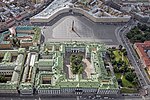Wawelberg Bank building
1912 establishments in the Russian EmpireAeroflotArt Nouveau architecture in Saint PetersburgArt Nouveau commercial buildingsBank buildings in Russia ... and 3 more
Buildings and structures in Saint PetersburgCommercial buildings completed in 1912Nevsky Prospekt

The Wawelberg Bank Building in St. Petersburg, Russia was built by the Wawelbergs - a prominent Polish banking family active in the Russian Empire. Although this building bears initials HW (Hipolit Wawelberg), it was commissioned by his son, Michael Wawelberg. The Wawelberg Bank Building is an object of cultural heritage of federal significance.
Excerpt from the Wikipedia article Wawelberg Bank building (License: CC BY-SA 3.0, Authors, Images).Wawelberg Bank building
Nevsky prospect, Saint Petersburg Apraksin Dvor (округ № 78)
Geographical coordinates (GPS) Address Website Nearby Places Show on map
Geographical coordinates (GPS)
| Latitude | Longitude |
|---|---|
| N 59.93665 ° | E 30.314198 ° |
Address
Вавельберг
Nevsky prospect 7-9
190107 Saint Petersburg, Apraksin Dvor (округ № 78)
Saint Petersburg, Russia
Open on Google Maps










